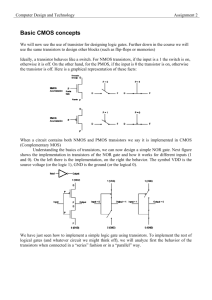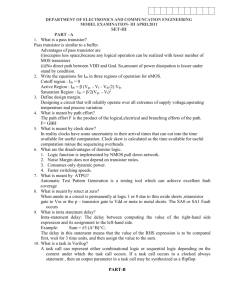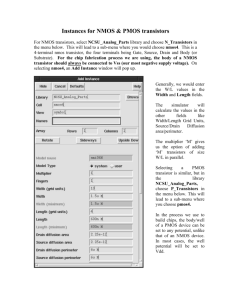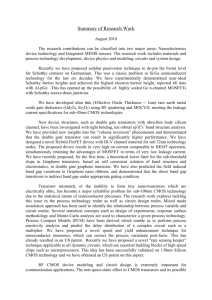CHAPTER 1: CMOS CIRCUITS
advertisement
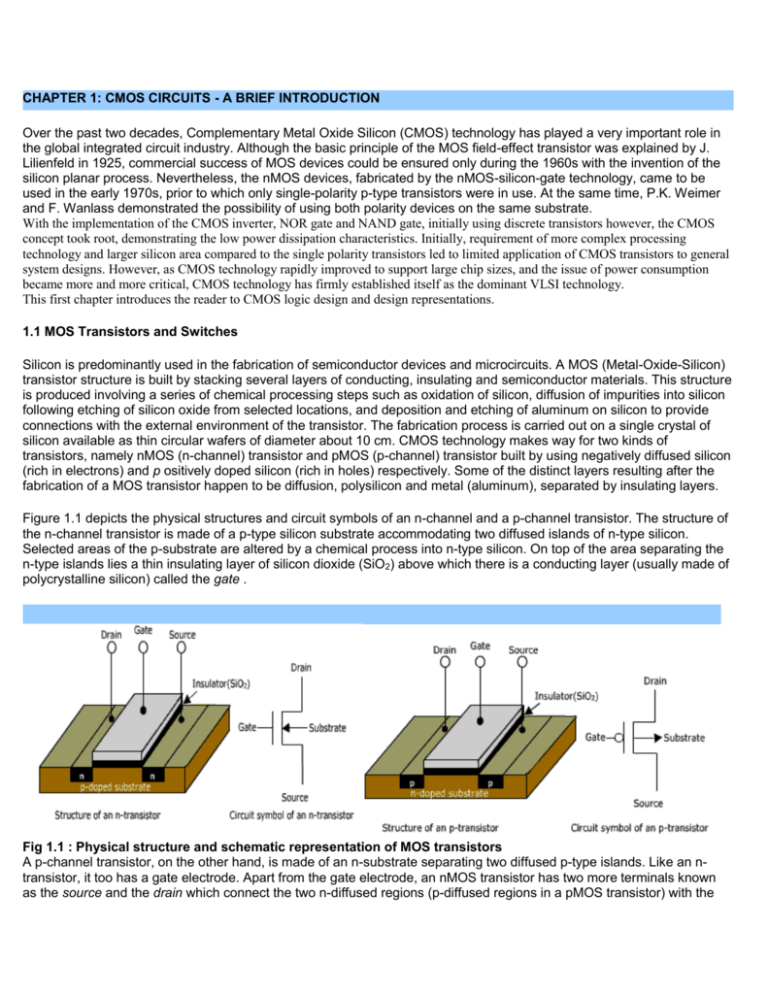
CHAPTER 1: CMOS CIRCUITS - A BRIEF INTRODUCTION Over the past two decades, Complementary Metal Oxide Silicon (CMOS) technology has played a very important role in the global integrated circuit industry. Although the basic principle of the MOS field-effect transistor was explained by J. Lilienfeld in 1925, commercial success of MOS devices could be ensured only during the 1960s with the invention of the silicon planar process. Nevertheless, the nMOS devices, fabricated by the nMOS-silicon-gate technology, came to be used in the early 1970s, prior to which only single-polarity p-type transistors were in use. At the same time, P.K. Weimer and F. Wanlass demonstrated the possibility of using both polarity devices on the same substrate. With the implementation of the CMOS inverter, NOR gate and NAND gate, initially using discrete transistors however, the CMOS concept took root, demonstrating the low power dissipation characteristics. Initially, requirement of more complex processing technology and larger silicon area compared to the single polarity transistors led to limited application of CMOS transistors to general system designs. However, as CMOS technology rapidly improved to support large chip sizes, and the issue of power consumption became more and more critical, CMOS technology has firmly established itself as the dominant VLSI technology. This first chapter introduces the reader to CMOS logic design and design representations. 1.1 MOS Transistors and Switches Silicon is predominantly used in the fabrication of semiconductor devices and microcircuits. A MOS (Metal-Oxide-Silicon) transistor structure is built by stacking several layers of conducting, insulating and semiconductor materials. This structure is produced involving a series of chemical processing steps such as oxidation of silicon, diffusion of impurities into silicon following etching of silicon oxide from selected locations, and deposition and etching of aluminum on silicon to provide connections with the external environment of the transistor. The fabrication process is carried out on a single crystal of silicon available as thin circular wafers of diameter about 10 cm. CMOS technology makes way for two kinds of transistors, namely nMOS (n-channel) transistor and pMOS (p-channel) transistor built by using negatively diffused silicon (rich in electrons) and p ositively doped silicon (rich in holes) respectively. Some of the distinct layers resulting after the fabrication of a MOS transistor happen to be diffusion, polysilicon and metal (aluminum), separated by insulating layers. Figure 1.1 depicts the physical structures and circuit symbols of an n-channel and a p-channel transistor. The structure of the n-channel transistor is made of a p-type silicon substrate accommodating two diffused islands of n-type silicon. Selected areas of the p-substrate are altered by a chemical process into n-type silicon. On top of the area separating the n-type islands lies a thin insulating layer of silicon dioxide (SiO2) above which there is a conducting layer (usually made of polycrystalline silicon) called the gate . Fig 1.1 : Physical structure and schematic representation of MOS transistors A p-channel transistor, on the other hand, is made of an n-substrate separating two diffused p-type islands. Like an ntransistor, it too has a gate electrode. Apart from the gate electrode, an nMOS transistor has two more terminals known as the source and the drain which connect the two n-diffused regions (p-diffused regions in a pMOS transistor) with the external environment of the device. The gate acts as a control input, regulating the current flow between the source and the drain. Although the source and the drain are physically equivalent, the name source is reserved for the terminal by which the current carriers enter the device, whereas the drain refers to the terminal by which the carriers leave the device. As shown in Figure 1.1, the substrate (also called the body) happens to be the fourth terminal of a MOS transistor. The voltage applied at the gate terminal regulates the flow of current between the source and the drain. In this way, a MOS transistor may be viewed as a simple on/off switch. Assume that '1' or POWER (PWR) or VDD denotes a high voltage normally between 1.5 to 15 volts, and '0' or GROUND (GND) or VSS stands for a low voltage normally set to zero volt. The "strength" of a signal denotes its ability to source or sink current. The strength of '1' and '0' signal can vary. One may distinguish between an output and an input in that an output is a source of stronger '1's and '0's than an input. Figure 1.2 : Switch models of MOS transistors The switch models of both nMOS and pMOS transistors are depicted in Figure 1.2. As shown in Figure 1.2(a), an nMOS switch is deemed closed or `ON' if the gate voltage is at logic '1' voltage, or more precisely if the potential between the gate and the source terminals, namely VGS happens to be greater than a threshold voltage VT. A closed nMOS switch implies the existence of a continuous channel between the source and the drain terminals. On the other hand, an 'OFF' or open nMOS switch indicates the absence of a connecting channel between the source and the drain. Similarly, a pMOS switch is considered 'ON' or closed if the potential VGS is smaller or more negative than the threshold voltage VT. Threshold voltage and related issues will be dealt with in detail in the next chapter. 1.2 CMOS Logic---- Inverters, Combinational Logic, NAND and NOR gates, Compound gates and Multiplexers, Memories This section gives an overview of CMOS logic elements that find use in different applications. Figure 1.3 : Symbol, circuit structure and truth table of a CMOS inverter 1.2.1: Inverter: The inverter is universally accepted as the most basic logic gate doing a Boolean operation on a single input variable. Figure 1.3 depicts the symbol, truth table and a general structure of a CMOS inverter. As shown, the simple structure consists of a combination of an pMOS transistor at the top and a nMOS transistor at the bottom. The truth table shows a logic '1' output corresponding to a logic '0' in the input. This can be ensured by the p-transistor whose source is connected to a logic '1' source ( VDD ) and gate is provided a logic '0' stimulus. Similarly, a logic '0' output will result from a logic '1' input. The nMOS transistor connected in the bottom realizes this when its gate is given a logic '1' input and its source is connected to logic '0' or ground (VSS). The inverter can best be considered as the central part of digital designs. A thorough understanding of its operation and properties is required to design more complex structures like NAND and NOR gates, adders and multipliers. 1.2.2 Combinational Logic Combinational logic circuits, rather gates, perform Boolean operations on multiple input variables and determine the outputs as Boolean functions of the inputs. The basic two-input AND and OR functions can be realized by series and parallel combinations of nMOS and pMOS transistors as shown in Figure 1.4. Figure 1.4 : Connection of series and parallel n-switches and p-switches If two nMOS switches are in series to produce AND function as shown in Figure 1.4(a), both of them should be closed (or ON) by connecting their gates to logic `1'. Similarly, to obtain a two-variable AND function by pMOS switches as shown in Figure 1.4(b), the gates should be fed by logic `0' signals. On the other hand, a two-input OR function is realized by placing two nMOS transistors (Figure 1.4(c)) or two pMOS transistors (Figure 1.4(d)) in parallel. The OR switch by nMOS transistors is closed if any one of the transistors is ON (that is, if any input is at logic `1'). At the same time, the OR function based on pMOS transistors is realized by placing logic `0' at either input. 1.2.3 NAND and NOR Gates Figure 1.5 depicts CMOS implementation of a two-input NAND gate and its typical symbol. The pull-down sub-circuit is made of a series combination of two nMOS transistors. These are responsible for conducting logic '0' to the output node when both of the gates are at logic '1'. Figure 1.5 : A two-input CMOS NAND gate and its symbol The pull-up path on the other hand consists of a parallel combination of two pMOS transistors. If either of the is at logic `0', the output node assumes the value `1'. The two symbols shown in Figure 1.5(b) for a two-input NAND gate is due to the equivalence given by, Figure 1.6 depicts CMOS implementation of a two-input NOR gate and its typical symbol. The pull-up sub-circuit is made of a series combination of two pMOS transistors. These are responsible for conducting logic `1' to the output node when both of the gates are at logic `0'. The pull-down path on the other hand consists of a parallel combination of two nMOS transistors. If either of the is at logic `1', the output node assumes the value `0'. The two symbols shown in Figure 1.6(b) for a two-input NOR gate is due to the equivalence 1.2.4 Compound Gate and Multiplexers Complex Boolean functions of multiple input variables can be realized by simple extension of the circuit structures developed for the basic NAND and NOR gates discussed above. Consider the boolean function whose CMOS implements is shown in fig 1.7. The output node attains the logic `1' owing to the pMOS sub-circuit. One can easily see that driving both the gate inputs (labeled A and B ) of the pMOS transistors or driving the inputs (labeled C and D ) of the series pMOS transistors achieves the output `1'. Due to the complementary nature of the pMOS and nMOS transistors, any series combination of transistors in the nMOS tree gets replaced by a parallel connection in the pMOS tree and vice versa. To implement a multiplexer, one can use complementary switches. Figure 1.8 depicts how to realize a 2-input multiplexer in CMOS design style. The circuit shown in Figure 1.8(a) consists of two transmission gates, each consisting of an nMOS and a pMOS transistors. Note that the upper transmission gate allows input A to be passed to the output when the gate control C is at logic '0'. Also, the lower transmission gate transmits the input B to the output when its gate control C is at logic '1'. Thus both the transmission gates are not simultaneously open for their respective input signals to pass to the common output node. This in essence constitutes a 2-input multiplexer with control input C and two data inputs A and B. Figure 1.8(b) shows the commonly used symbol for a 2-input multiplexer. Figure 1.8 : CMOS implementation of a 2-input multiplexer 1.2.5 Memory : Latch and Register Semiconductor memory capable of storing large amount of information are essential to all digital systems. In its simplest form, a single-bit memory element can be realized as a latch or a register. A latch is a level-sensitive circuit for which the state of the output depends on the level of the clock signal. It passes the D input to the Q output when the clock signal is high (for a positive latch ) or when the clock is low (in case of a negative latch ). This latch is then said to be in transparent mode. During the low state of the clock, for a positive latch, the input data sampled at the falling edge of the clock is held stable at the output; the latch is now said to be in hold mode. The input should be stable for a short period around the falling edge of the clock to meet setup and hold requirements. Figure 1.9 depicts a positive level-sensitive latch implemented using a 2-input multiplexer and two inverters. It has a data input D, a clock input Clk, and two outputs Q and Q. The output Q follows the input D when Clk=`1'. When Clk=`0', the D input is ignored, and the state of output Q is retained. Similarly, a negative latch passes the D input to the Q output when the clock signal is low. Figure 1.9 : A CMOS positive level-sensitive D latch One can use a negative latch followed by a positive latch to realize an edge-triggered register, as shown in Figure 1.10. When the clock signal is low, the output of the first stage, normally referred to as the master stage, follows the D input, whereas, the output Q of the second stage, commonly known as the slave stage, retains the previous value. When a transition 0 à 1 takes place in the clock input, the value of the slave output Q freezes at the value of D input existing just before the rising edge of the clock. As the sampling of the input takes place on a 0 à 1 clock transition, this register is called a positive edge-triggered register. When the clock remains at logic `1', the master stops sampling the D input and stores the D value at the time of the clock transition. Now, the slave latch allows the complement of the stored master value to pass to the output Q . The D input cannot affect the output Q as the master stage is disconnected from the D input. When the clock makes a transition from `1' to `0', the slave stage is disconnected from the master stage and gets locked to its previous value due to the feedback loop. Also, the master stage begins sampling the D input again. A negative edge-triggered register is one in which during a 1 → 0 transition, the value of the output Q freezes at the value of D input existing just before the falling edge of the clock. It is realized by reversing the order of the two latches shown in Figure 1.10. Figure 1.10 : A CMOS positive edge-triggered D register 1.3 Circuit and System Representation - Behavioural, Structural and Physical Representation A complex digital system is broken down into component gates and memory elements by splitting the system in a hierarchical manner. A set of requirements is envisaged. Guided by these, an initial design is developed an subsequently tested against the requirements. Design is made to improved in case the requirements are not met. The Y-chart (first conceived by D. Gajski) shown in Figure 1.11 demonstrates a simplified design flow that is adopted for the majority of logic chips, using the activities on three different axes (domains) which resemble the letter "Y". The three domains of representation that make up the Y-chart are the behavioural domain, the structural domain and the physical layout domain. The behavioural view of a digital system describes its function of the system with no regard to its implementation. The structural view of a system describes a system as an interconnection of components. The physical view of a system is concerned with the physical entities, namely the transistors that constitute the circuit. Physical Layout Domain The design flow at the behavioural domain starts from the algorithm that specifies the operation of the target chip. The architecture of the corresponding processor in the structural domain is envisaged. It is projected onto the chip surface in the physical (geometrical) layout domain by floor-planning . Physical Layout Domain Figure 1.11 : Three domains of IC design flow. The next development along the axis of the behavioural domain happens to be the finite state machines (FSMs) which are realized at the structural plane by functional modules such as registers, adders, multipliers and arithmetic logic units (ALUs). The automatic placement and routing of these modules are then done on the physical plane with an objective of minimizing the area occupied by the interconnects and signal delay. Next phase of refinement on the behavioural level is the behavioural description of the module. At the structural level, the target chip is now described in terms of the logic gates (or leaf cells ) which can be placed and interconnected using a cell placement and routing program. The last major refinement at the behavioural plane is concerned with the detailed Boolean description of the leaf cells followed by a transistor level realization of the leaf cells and mask generation . Actually, the leaf cells are pre-designed at the transistor level in the standard-cell based design style, and stored in a library for logic implementation.



